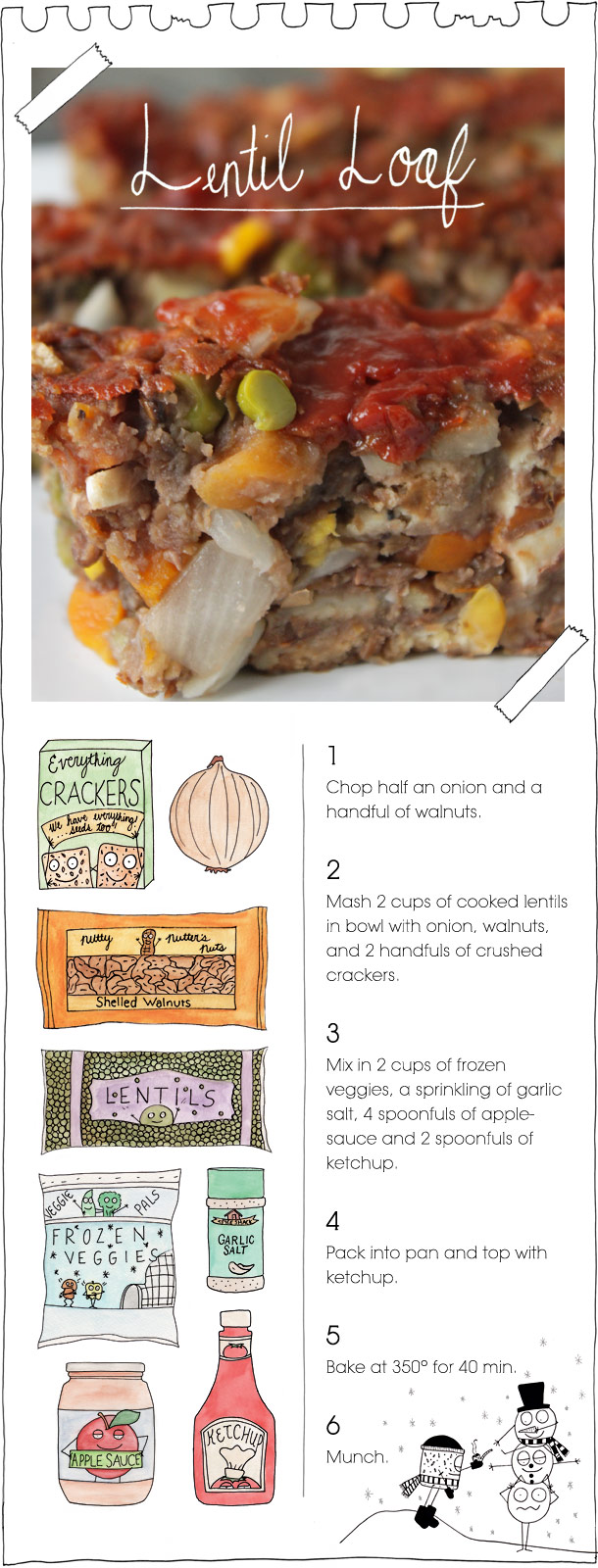
Eating alone is not one of those things that our society prepares us for once we reach adulthood. Many North Americans are unfamiliar with their kitchen appliances and know very little of proper food preparation.
But eating cheaply and well can be done without any fancy schooling, and even if you are a single lady, oh, oh, oh.
My first advice to you? Invest in a few tools! No handy-person would show up to the job without their tools. Approach feeding yourself this way and it will make life a breeze.

The first tool you need is a good knife, and by good I don’t mean you have to buy a hundred dollar knife, but making an educated purchase from a specialist retailer – like an actual kitchen supply store, and not a department store will ensure you have the knife you need. Just begin by inquiring about knives, ask to hold one so you can test the weight (see if it’s comfortable). It doesn’t need to be too heavy or too fancy, but you should look for something which feels both confident in your hands, and is dependable. I always look for a knife with a long ‘tang’, this means that the blade extends the full length of the handle, increasing both stability, and ensuring I will never need to worry about handles breaking-off. Ask about price ranges and make sure you state up front that your aren’t looking to spend a fortune and see if they’ll throw in a knife sharpener for free.
 And, while you’re at the kitchen supplies store… invest in some regular ol’ measuring cups and spoons, and if you can, invest in a quart sized liquid measuring cup. These should just about cover all bases in the measuring department. You don’t even need a fancy-shmancy scale to get the job done.
And, while you’re at the kitchen supplies store… invest in some regular ol’ measuring cups and spoons, and if you can, invest in a quart sized liquid measuring cup. These should just about cover all bases in the measuring department. You don’t even need a fancy-shmancy scale to get the job done.
 The last tool(s) I would insist that you invest in are quality tupper-ware and food storage containers (be them bags or not, whatever tickles your fancy, really). I prefer being a little nicer to mother earth by purchasing reusable containers. I look for tempered glass which can withstand both freezing as well as oven temperatures, in similar sizes (for easy fridge/freezer organization) and just large enough to hold food for two servings (which I will address in my article about freezing and storing food). I suggest investing in re-usable freezer bags, but regular ziplock baggies will work if you have them around. Although, you can find some very affordably priced reusable freezer and fridge storage bags here in the LoveForEarth etsy shop.
The last tool(s) I would insist that you invest in are quality tupper-ware and food storage containers (be them bags or not, whatever tickles your fancy, really). I prefer being a little nicer to mother earth by purchasing reusable containers. I look for tempered glass which can withstand both freezing as well as oven temperatures, in similar sizes (for easy fridge/freezer organization) and just large enough to hold food for two servings (which I will address in my article about freezing and storing food). I suggest investing in re-usable freezer bags, but regular ziplock baggies will work if you have them around. Although, you can find some very affordably priced reusable freezer and fridge storage bags here in the LoveForEarth etsy shop.
Now that you have your tools, it’s time to get cooking. The most important advice I can give you here is measure, measure, measure. Eating alone is all about the realization of yield. Or how much an item changes in volume after it’s cooked. Now, your measurements don’t need to be exact in most cases – these aren’t volatile chemicals in science class, they are potatoes – however, it is always good to measure ingredients fairly accurately to insure both A) you don’t cook more than you need and B) so you don’t end up with all potato and no butter; meaning it’s much easier to spice something if you know how much you are actually cooking. You might also want to work on brushing up on your fractions when attempting to scale down recipes. But hey, you can almost always look up how many teaspoons are in a quarter cup on the ol’ interwebs.
Have you ever cooked too much pasta? Or too little? Pasta is the most common go-to food for when you need to eat fast, yet, pasta is tricky and odd shaped, and it doesn’t really fit in a measuring cup very well. I’ll let you in on a few tricks about the different kind of pastas and how you can easily measure them for the perfect fast and easy meal for one.

There are three basic types of pasta, the first of which I will address are spaghetti and linguine. The easiest way to measure these types of pasta without a scale is to grab a handful between your thumb and pointer finger. A hand full about the diameter of a 25 cent coin is about 2 ounces of pasta, or the average size for a light meal or pasta side dish. If you are going to be having pasta as your main course you can increase this to 3 or 4 ounces, or two ’25 cent’ hand-fulls, personally, I find this is too much pasta and usually go with a middle ground.
 For measuring smaller pastas such as macaroni or penne this is when your quart cup measuring cup comes in handy, because they are bit wider than the ‘stackables’ and pasta can lay quite comfortably. Pasta like these usually double in volume, so half a cup to three fourths is about a two ounces of dry pasta and cooks to just about a cup.
For measuring smaller pastas such as macaroni or penne this is when your quart cup measuring cup comes in handy, because they are bit wider than the ‘stackables’ and pasta can lay quite comfortably. Pasta like these usually double in volume, so half a cup to three fourths is about a two ounces of dry pasta and cooks to just about a cup.
Egg noodles, are similar to other pastas, but tend to double or even triple in size when cooked, which can be tricky. I find that a fourth a cup is about two ounces of dry pasta and will be just over a whole cup when cooked.
 Now, all people are different; some people have smaller/larger appetites than others. This series has nothing to do with portion control, but simply how to gauge food so you waste less when eating alone. If you try the measurements above and find that it is too much, or too little, please feel free to adjust accordingly as that leads to more effective cooking.
Now, all people are different; some people have smaller/larger appetites than others. This series has nothing to do with portion control, but simply how to gauge food so you waste less when eating alone. If you try the measurements above and find that it is too much, or too little, please feel free to adjust accordingly as that leads to more effective cooking.
It’s also very important to measure when cooking other grains such as rice, oatmeal, and barely. I suggest investing in a cookbook on grains that can guide you through how to cook each grain perfectly or consulting the internet for the specific grain as there are many forums and cooking websites which discuss the yields of different grains. Though I will share with you the method I use to get the perfect steamed rice.
Through my experience, 1/2 a cup of dry rice has proven to be the perfect amount for a main course for one person and ends up about equalling about 1 cup cooked. To get the perfect steamed rice it is very important not to have too much water as the grain will become mushy and tasteless. For every 1 cup of rice you need 1 and 1/2 cup water and for a 1/2 cup you need just under a whole cup of water, or about 3/4ths. You will need a pot that has a tight fitting lid. If you are worried that your lid doesn’t close tight enough you can put a piece of tin foil between the lid and the pot and turn down the sides. I learned that from Madhur Jaffrey Indian Cooking, an excellent cookbook by the way. Add the rice and the water together into the pot, set the stove element to high and wait for it to boil. Once the rice and water come to a boil cover and turn the temperature down to low and simmer for 10 to 15 minutes. After 15 minutes check the grains, if they are done enough to your liking remove from element, fluff with a fork, and serve. If not remove from the element and keep the rice covered for another 10 minutes undisturbed. After the 10 minutes the rice should be perfectly steamed.
Having the right tools as well as being more aware of food yields will make cooking and preparing the proper amount of food for one person much easier. Especially when it comes to grains like pasta and rice which don’t keep very well and are quick to make.
Be sure to check back for Eating alone: Part 2 – If you liked it then you shoulda put a label on it.
<<<Eating alone: Introduction and the logistics of food snobbery
Photo sources: 1|2|3|4|5|6|7







 And, while you’re at the kitchen supplies store… invest in some regular ol’ measuring cups and spoons, and if you can, invest in a quart sized liquid measuring cup. These should just about cover all bases in the measuring department. You don’t even need a fancy-shmancy scale to get the job done.
And, while you’re at the kitchen supplies store… invest in some regular ol’ measuring cups and spoons, and if you can, invest in a quart sized liquid measuring cup. These should just about cover all bases in the measuring department. You don’t even need a fancy-shmancy scale to get the job done. The last tool(s) I would insist that you invest in are quality tupper-ware and food storage containers (be them bags or not, whatever tickles your fancy, really). I prefer being a little nicer to mother earth by purchasing reusable containers. I look for tempered glass which can withstand both freezing as well as oven temperatures, in similar sizes (for easy fridge/freezer organization) and just large enough to hold food for two servings (which I will address in my article about freezing and storing food). I suggest investing in re-usable freezer bags, but regular ziplock baggies will work if you have them around. Although, you can find some very affordably priced reusable freezer and fridge storage bags
The last tool(s) I would insist that you invest in are quality tupper-ware and food storage containers (be them bags or not, whatever tickles your fancy, really). I prefer being a little nicer to mother earth by purchasing reusable containers. I look for tempered glass which can withstand both freezing as well as oven temperatures, in similar sizes (for easy fridge/freezer organization) and just large enough to hold food for two servings (which I will address in my article about freezing and storing food). I suggest investing in re-usable freezer bags, but regular ziplock baggies will work if you have them around. Although, you can find some very affordably priced reusable freezer and fridge storage bags 
 For measuring smaller pastas such as macaroni or penne this is when your quart cup measuring cup comes in handy, because they are bit wider than the ‘stackables’ and pasta can lay quite comfortably. Pasta like these usually double in volume, so half a cup to three fourths is about a two ounces of dry pasta and cooks to just about a cup.
For measuring smaller pastas such as macaroni or penne this is when your quart cup measuring cup comes in handy, because they are bit wider than the ‘stackables’ and pasta can lay quite comfortably. Pasta like these usually double in volume, so half a cup to three fourths is about a two ounces of dry pasta and cooks to just about a cup.











